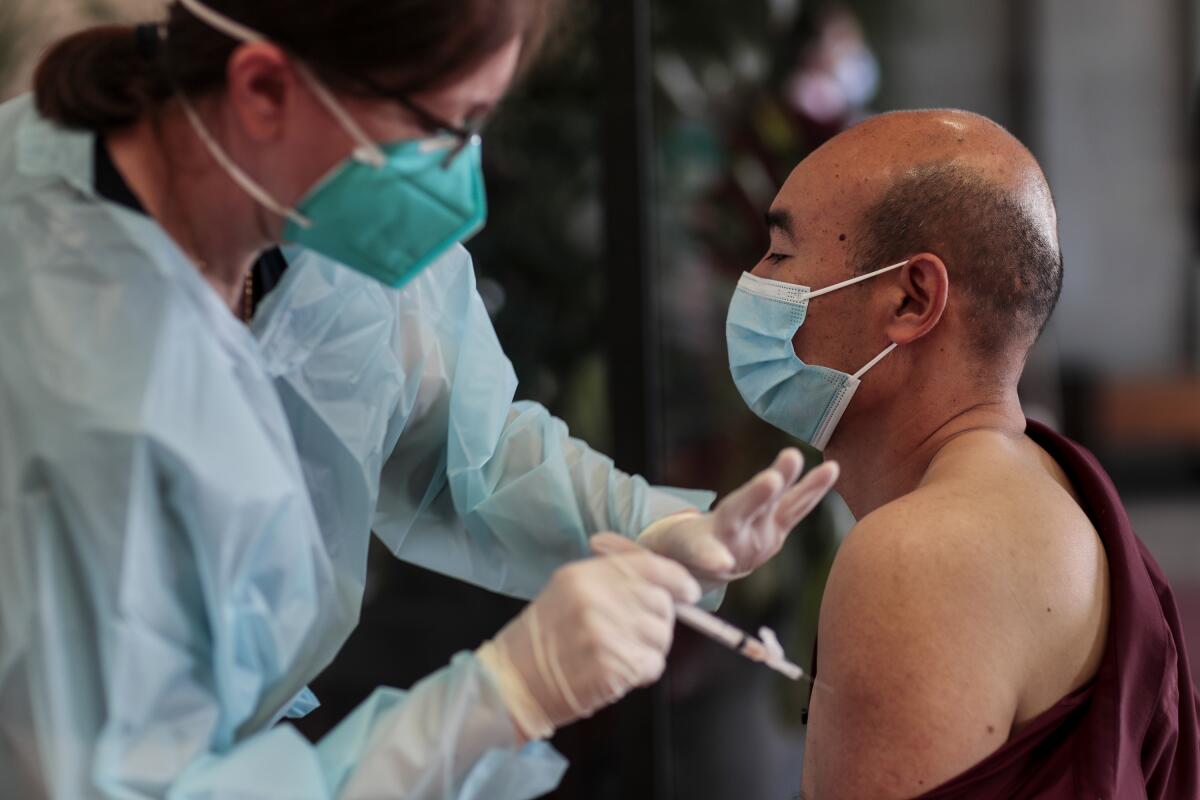As underserved areas grapple with vaccine inequities, Sean Penn’s nonprofit joins effort to get doses to residents

- Share via
Actor Sean Penn’s nonprofit, which has been central to operating vaccination and testing sites in Los Angeles, has launched an awareness campaign aimed at increasing inoculations in communities of color hit hardest by the COVID-19 pandemic.
CORE’s initiative, called It’s Time Los Angeles, arrives amid continued calls to prioritize equity in the vaccine rollout even as data show that Black and brown communities continue to lag behind in access.
For its campaign, CORE tapped culturally and linguistically competent leaders and organizations to get the word out on the importance of vaccination to the areas they serve, nonprofit co-founder and CEO Ann Lee said.
Communities “survive crises, over and over and over again. They’re the warriors that figure things out,” Lee said. “If you tap into that, and leverage and harness that incredible wealth of knowledge … and the work they do every day, and take it to scale, that’s what’s going to [bring] change.”
The nonprofit found that messaging based purely around science isn’t very effective to address vaccine hesitancy.
“A lot of people change their mind because of people that they trust and they know who are also getting vaccinated,” Lee said. “They trust their doctors, their religious leaders. They trust people who are pillars in the community.”
Experts say about most Americans will need to be vaccinated to bring the coronavirus pandemic under control. Track California’s progress toward that goal.
Last month, California began devoting 40% of its vaccine supply to underserved communities, where people have died of COVID-19 in much higher numbers.
Vaccination rates in those areas have seen strides since then, but continue to lag behind both wealthier neighborhoods and the county as a whole, according to a Times data analysis.
Some neighborhoods in South Los Angeles — where the spread of the coronavirus was particularly devastating — saw the biggest increase in how many of their residents had received at least one vaccine dose between March 1 and April 12.
Despite the gains, these areas are still seeing vaccine rates below the county average.
In each of the 10 communities that have experienced the largest relative gains over the last six weeks, the share of the population ages 16 and older who have received at least one vaccine dose remains under 30%. By comparison, 37.1% of L.A. County residents 16 and older had received at least one vaccine dose as of April 4, according to public health data.
Myriad overlapping factors likely underpin the disparity. There’s vaccine hesitancy, which can grow out of a lack of in-language information or eroded trust in government institutions.
Then there are issues of access. Some residents in these communities that skew lower-income don’t have a computer or a vehicle — two things that make getting a vaccine a lot easier. The former aids in booking an appointment and the latter in getting individuals to it.
Help leaders can offer includes providing accurate information and clarifying misconceptions in a language community members understand, said Angelica Salas, executive director of the Coalition for Humane Immigrant Rights of Los Angeles, or CHIRLA.
Salas said her organization, which is part of the It’s Time campaign, spends significant time letting people know that they’re eligible to receive a vaccine regardless of their immigration status. That requires answering questions about confidentiality and concerns over negative repercussions, she said.
Recently, Salas met a street vendor in her 70s who happened to pass by a vaccination site and asked if she was eligible. Healthcare workers told her she was and they could vaccinate her that day. She happily accepted.
“She’s older, she’s an immigrant, and she’s exposing herself just by the nature of being a street vendor,” Salas said. “Those are the folks who we want to target: people who think that they don’t qualify, they can’t get it. And yet they desperately need it.”
Outreach is time-consuming and far from fail-safe. Out of 500 conversations, 200 people might go forward with getting a shot, she said.
Dr. Rohit Varma, chief medical officer at CHA Hollywood Presbyterian Medical Center, said he encounters concerns over vaccines, but is focused on getting it to those who want it.
The hospital, along with the Southern California Eye Institute, of which Varma is a founding director, partnered with L.A. Councilman Mark Ridley-Thomas to create a walk-up vaccine clinic primarily serving areas of South Los Angeles in the councilman’s district.
Operating on Tuesday mornings, the clinic will provide about 300 shots a session. The people the clinic will serve “belong to pretty much every racial and ethnic group,” he said. Many don’t have access to reliable transportation or computers, and some are unhoused.
“I think that there is still a huge pent-up need that exists for people who want the vaccine, and are willing to get it, but in large measure don’t have access to it,” Varma said.
Times staff writers Luke Money and Matt Stiles contributed to this report.
More to Read
Sign up for Essential California
The most important California stories and recommendations in your inbox every morning.
You may occasionally receive promotional content from the Los Angeles Times.












